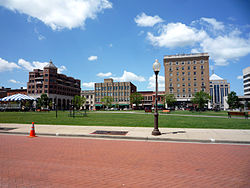Wausau, Wisconsin
| Wausau, Wisconsin | ||
|---|---|---|

Downtown Wausau skyline
|
||
|
||
 Location in Wisconsin |
||
| Coordinates: 44°57′N 89°38′W / 44.950°N 89.633°W | ||
| County | Marathon | |
| Government | ||
| • Mayor | Robert Mielke | |
| Area | ||
| • City | 20.04 sq mi (51.90 km2) | |
| • Land | 18.78 sq mi (48.64 km2) | |
| • Water | 1.26 sq mi (3.26 km2) | |
| Elevation | 1,207 ft (368 m) | |
| Population (2010) | ||
| • City | 39,106 | |
| • Estimate (2012) | 39,160 | |
| • Density | 2,082.3/sq mi (804.0/km2) | |
| • Metro | 134,063 | |
| Time zone | Central (UTC–6) | |
| • Summer (DST) | Central (UTC–5) | |
| ZIP Code | 54401 | |
| Area code(s) | 715 & 534 | |
| Website | www |
|
Wausau is a city in and the county seat of Marathon County, Wisconsin, United States. The Wisconsin River divides the city into east and west. The city is adjacent to the Town of Wausau.
As of the 2010 census, Wausau had a population of 39,106. It is the core city of the Wausau Metropolitan Statistical Area (MSA), which includes all of Marathon County and had a population of 134,063 at the 2010 census.
This area was occupied for thousands of years by succeeding cultures of indigenous peoples. The historic Ojibwe (also known in the United States as the Chippewa) occupied it in the period of European encounter. They had a lucrative fur trade for decades with French colonists and French Canadians. After the French and Indian War this trade was dominated by British-American trappers from the eastern seaboard.
The Wisconsin River first drew European-American settlers to the area during the mid-19th century as they migrated west into the Great Lakes region following construction of the Erie Canal in New York State. This provided a route for products from the region to the large New York and other eastern markets. The area had been called "Big Bull Flats" or "Big Bull Falls" by French explorers, who were the first Europeans here. They named it for the long rapids in the river, which created many bubbles, called bulle in French. By an 1836 treaty with the United States, the Ojibwe ceded much of their lands in the area to federal ownership. It was sold to non-Native peoples. Wausau means "a faraway place" or "a place which can be seen from far away" in the Ojibwe language.
George Stevens, the namesake for the city of Stevens Point located south of Wausau, began harvesting the pine forests for lumber in 1840 and built a saw mill. Lumbering was the first major industry in this area, and other sawmills along the Wisconsin River were quickly constructed by entrepreneurs. By 1846, Walter McIndoe arrived and took the lead in the local business and community. His efforts helped to establish Marathon County in 1850. Word of Stevens' success in the region spread across the country throughout the logging industry. Loggers came from Cortland County, New York, Carroll County, New Hampshire, Orange County, Vermont and Down East Maine in what is now Washington County, Maine and Hancock County, Maine. These were "Yankee" migrants, that is to say they were descended from the English Puritans who had settled New England during the 1600s.
...
Wikipedia

